The week at a glance
- White-crowned Sparrow in Norfolk
- Barrow's Goldeneye still in County Down
- Putative Thayer's Gull still in Oxfordshire
- Cattle Egret invasion continues
- American Buff-bellied Pipit still in County Cork
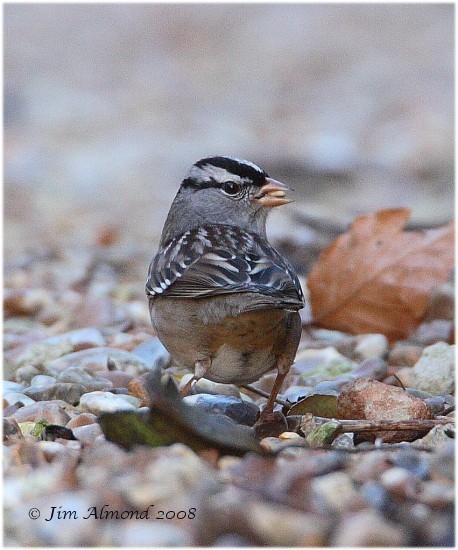
White-crowned Sparrow, Cley next the Sea, Norfolk (Photo:
Jim Almond)
In 2007, many people were somewhat taken aback by the amazing news of the Pacific Diver (in Yorkshire) at the end of the very first month of the year. In 2008, the first major surprise of the new birding year has come within the very first week. So, with the last bubble in the champagne glass having only just popped, it was time to reach for another bottle to celebrate the remarkable discovery of an adult White-crowned Sparrow in Cley (Norfolk). The startlingly handsome bird was first noted by keen garden birdwatchers on the 3rd and identified, by the householders, the following day on a trip to Norwich. A careful, and very sensible, plan was put in place over the days that followed which allowed as many observers as possible the chance to enjoy this ultra-rare Nearctic vagrant. And enjoy it they did, until 9th. This bird was the fifth record for Britain and Ireland (excluding a record at sea, off Ireland, in 1948), and followed a tail-less bird in County Cork in May 2003, and a one-day wonder on Merseyside in October 1995. And for those worrying about the provenance of such an outrageous visitor to the east-coast county in midwinter, this bird follows in the footsteps of the first of Norfolk's two Black-and-white Warblers (in December 1985) and the Red-breasted Nuthatch (that lingered from October 1989 to May 1990), while nearby Lincolnshire hosted a wintering White-throated Sparrow in the winter of 1992-93. In Oxfordshire, the Thayer's Gull lookalike was still being seen around Dix Pit and Stanton Harcourt on 5th and 6th. In Ireland, the drake Barrow's Goldeneye was again seen at Quoile Pondage (Co. Down) on 6th, while down in County Cork, the American Buff-bellied Pipit was still present near Youghal on the first day of the new year.
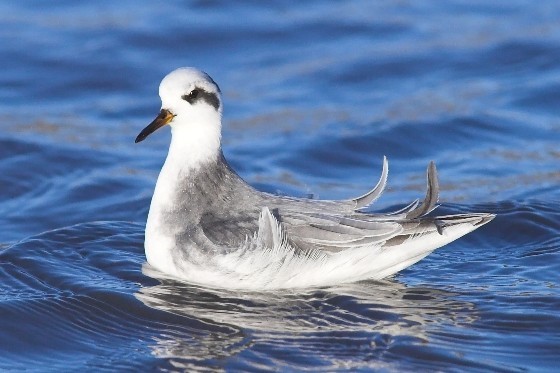
Grey Phalarope, Stinky Bay, Benbecula, Outer Hebrides (Photo:
Terry Fountain)

Grey Phalarope, Kenfig Pool NNR, Glamorgan (Photo:
Luke Phillips)
Two White-billed Divers were noted in Bluemull Sound, between Unst and Fetlar (Shetland) on 7th. Two Manx Shearwaters were reported during the week, one seen from the pier at Walton-on-the Naze (Essex) on 3rd, with another some way further north, seen off Anstruther (Fife); also on 3rd. Balearic Shearwaters included singles from Selsey Bill (West Sussex) and Cape Cornwall (Cornwall), both on 5th with one or two more around Portland and Weymouth Bay (Dorset) on 7th and 8th, while a Sooty Shearwater seen from St. Mary's (Scilly) on 9th was even more surprising. Skuas noted during the week included seven Great Skuas, four of which flew past Pendeen (Cornwall) on 5th, while at least 15 Pomarine Skuas were reported, from seven counties, including three past Herne Bay (Kent) on 3rd, with the same date saw at least three passing Canvey Island (Essex). Also an Arctic, or possibly a Long-tailed, Skua was seen over Bolton (Greater Manchester) on 5th. The week's Grey Phalarope tally was four, with one still in Stinky Bay, Benbecula (Outer Hebrides) to 4th, and others noted in Mount's Bay (Cornwall) on 3rd-6th, at Scarborough (N. Yorkshire) on 6th and at Kenfig Pool NNR (Glamorgan) on 7th-8th. Little Auks were in very short supply, aside from 57 that were seen flying past Annagh Head, on the Mullet (Co. Mayo) on 6th. Two were seen off the harbour at John O'Groats (Highland) on 3rd, with another noted offshore from Musselburgh Lagoons (Lothian) on 6th. Two flew by Carregwastad Point (Pembrokeshire) on 7th. Another bird was reported from Blackborough End tip (Norfolk) early in the week.
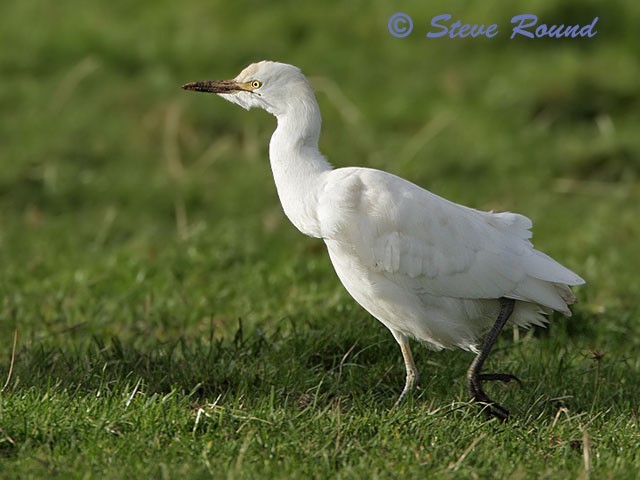
Cattle Egret, Neston, Cheshire (Photo:
Steve Round)

Great White Egret, Thorpeness, Suffolk (Photo:
Bill Plumb)
Cattle Egrets were still around in some number as the first full week of the New Year began, but with people heading back to work, the number of reports began to drop a little. It was still Cornwall that was at the forefront of the high figures, although it was being given a run for its money by County Cork. The largest group was still to be found around Drift and Sancreed (Cornwall) with 16 birds noted there on 5th-6th. Elsewhere in Cornwall, birds were noted at Crantock (seven there on 4th-5th rising to nine on the 6th), at Veryan (six there on 9th), at St. Breock (three present on 8th), on Trencrom Hill (four on 9th), along with singles near St. Ives and Morvah. In Devon, singles remained at Powderham to 5th and at Bideford to 6th, but three birds were there on 9th. Three singles were in Somerset, near Muchelney to 9th, at Stoke St. Michael also to 9th and a new bird, at Old Cleeve, on 6th-9th. Five birds remained at Buckland Ripers (Dorset) to 8th at least. The bird at Fretherne (Gloucestershire) remained until 7th, while singles remained in Hampshire, at Harbridge until 9th, in West Sussex, at East Lavant to 6th, and also in neighbouring East Sussex, at Rodmell to 8th and at Coombe Haven until 7th at least. In Wales, two birds were found in Ceredigion, at Dol-y-Bont from 3rd-6th and at Llanbadarn Fawr on 4th. Back into England and to Cheshire one was noted at Neston from at least 3rd-9th. Scotland's sole representative remained at Cardoness (Dumfries and Galloway) to 9th. In Ireland, County Cork managed to rattle up the numbers - two were at Milltown on 3rd, when four were at Bohonagh and five were at Clogheen Marsh. Two were at Cobh on 5th with three there the following day. Nine had roosted at Clonakilty on New Year's Day, while eight were at Rossmore on 8th. Elsewhere in the Republic, two remained at Dungarvan (Co. Waterford) to 5th, with another in Waterford itself on 4th. Up to the northwest and into County Donegal where a single bird was seen at Inch Island Lake on 6th. Several Great White Egrets were seen as 2008 got under way. Familiar faces remained in Hampshire to 6th and County Derry to 8th, but numerous wandering birds made up the rest of the reports for the week: at Paddington (East Sussex) on 3rd, at Thorpeness (Suffolk) from 3rd-9th (visiting North Warren RSPB on 4th-5th), on the Ouse Washes RSPB (Cambridgeshire) on 3rd-9th, at Cotswold Water Park (Wiltshire) on 5th-6th, at three sites across Norfolk between 5th and 7th, at Cossington Meadows NR (Leicestershire) on 5th, reappearing at Eyebrook Reservoir (Leicestershire) on 6th, and the final bird of the week reported near Sellafield (Cumbria) on 6th. The number of Spoonbills took a downward turn this week, with just seven birds recorded - singles were at St. Dogmaels (Pembrokeshire) from 3rd-6th, on the Cefni Estuary (Anglesey) from 3rd-7th and on the Fleet (Dorset) on 4th. Elsewhere in Dorset, four birds were in Poole Harbour on 5th-7th. The regular second-winter Glossy Ibis remained around Warton Marsh (Lancashire) to 6th at least. Another Glossy Ibis was seen at the North Slob WWR (Co. Wexford) on 1st January, with two birds present on 8th. Normally these round-ups of the week's birding activities will mention Common Cranes only in terms of the regular flock of birds in the Norfolk Broads. This week is, refreshingly, rather different. Two birds were seen on Mainland Orkney on 5th and the same day saw the arrival of a flock of 14 birds near Thurso (Highland), which stayed to the morning of 6th, with three birds there to 7th. A flock of 11 birds was reported flying in over the sea at Lossiemouth (Moray) on the afternoon of 6th. The wintering bird remained at Welney WWT (Norfolk) to 7th while just nine were reported from the Broads.

Black Duck, Blanket Nook, Lough Swilly, Donegal (Photo:
Dermot Breen)
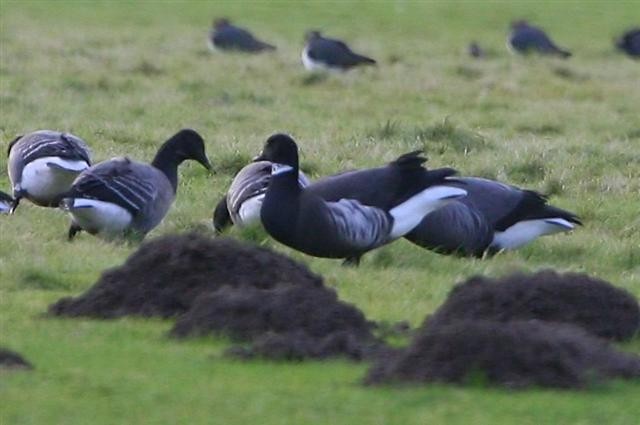
Black Brant, Wells-next-the-Sea, Norfolk (Photo:
Steve Stansfield)

Ferruginous Duck, Corbet Lough, Down (Photo:
Derek Charles)

American Wigeon, Langness, Isle of Man (Photo:
Pete Hadfield)
The stock of Ross's Goose has risen again this winter, and seems to have peaked with a group of three birds alongside some 10,000 Pink-footed Geese near Docking (Norfolk) on 3rd. Singles were still in the same area to 5th, with a single popping in to the dusk roost at Holkham (Norfolk) on 6th-7th, and one was near Cockthorpe on 9th. The white-morph Snow Goose remained elusive in north Norfolk but was seen near Brancaster Staithe on 3rd, Cockthorpe on 5th and Holkham on 9th. The white adult at Winless (Highland) was still present from 3rd-6th, while a juvenile was again on Orkney on 5th. The blue adult Snow Goose was still at West Freugh airfield (Dumfries and Galloway) on 4th. The adult Red-breasted Goose was still in West Sussex from 3rd-6th (around West Wittering), and also popped in to Hampshire on 5th and 8th-9th while the adult at Caerlaverock WWT (Dumfries and Galloway) was still present to 6th at least. East Anglia lay claim to most of the week's Black Brants - at least two adults remained around the Wells and Holkham area (Norfolk) to 9th, with singles at Titchwell RSPB and Snettisham RSPB, both on 5th. In Suffolk, three birds were noted, including one at Loompit Lake from 4th-7th. The adult remained on the Kingsbridge Estuary (Devon) to 6th, with other singles noted in West Sussex and Lincolnshire, while two Brants were at Chickerell (Dorset) on 4th. The two Richardson's Canada Geese were still at Ballyconnell (Co. Sligo) on 3rd, with at least one Richardson's and one Lesser Canada Goose seen on Islay (Argyll) between 4th and 7th. A Canada Goose sp. was at the North Slobs WWR (Co. Wexford) on 4th. The drake American Wigeon was still at Angle Bay (Pembrokeshire) to 5th, with a second drake being found at Langness (Isle of Man) on 7th, and still present on 8th. After a glut of records over the holiday period, the number of drake Green-winged Teal fell away sharply as the new week began. The long-staying bird on the Hayle Estuary (Cornwall) was still present to 8th, and the bird at Marshside RSPB (Lancashire) was still present to 3rd. Two drakes were noted in Lincolnshire, at Alkborough Flats until 4th with another at Whisby Pits NR on 6th. Elsewhere single drakes were at Cotswold Water Park (Wiltshire) on 5th-8th, and in Ireland at Belfast Lough RSPB (Co. Antrim) on 5th, at Kilcoole (Co. Wicklow) to 6th. Another drake was at Bell Harbour (Co. Galway) on 2nd. The hybrid Green-winged Teal x Teal remained at Minsmere RSPB (Suffolk) to 5th at least, while the female Blue-winged Teal on North Bull Island (Co. Dublin) was still present to 6th at least. Also in Ireland, the two drake Black Ducks remained in County Donegal, near Kerrykeel on Lough Swilly, both to 5th at least, while the drake Black Duck in Ventry Bay (Co. Kerry) was still present on 2nd January. Six Lesser Scaup were reported during the week. The popular first-winter drake was still on Draycote Water (Warwickshire) from 3rd-9th, with another first-winter drake seen in Oxfordshire, at Appleford Gravel Pits from 1st-9th. The adult drake remained on Coot Loch, Benbecula (Outer Hebrides) to 8th and another adult male was on Cheddar Reservoir (Somerset) on 9th. Single female Lesser Scaup remained on Fetlar (Shetland) to 7th and at Clea Lakes (Co. Down) to 6th. Ring-necked Ducks edged towards double figures this week - another species suffering from a post-Christmas drop in birds reported. Regular winter drakes remained in Somerset, Buckinghamshire and Co. Louth. The two drakes were still on Loch of Tingwall (Shetland) to 8th, while a bird in Ceredigion was again at an undisclosed site to 6th at least. The female Ring-necked Duck remained at Bassenthwaite Lake (Cumbria) from 3rd-9th and a new arrival was a female on Loch Morlich (Highland) on 8th. In County Down, the drake Ferruginous Duck was at Corbet Lough on 6th-7th, with a new drake at Llandegfedd Reservoir (Gwent) on 7th. The female Ferruginous Duck was at Theale GPs (Berkshire) on 3rd-5th at least. The drake King Eider was still in Mousa Sound (Shetland) on 5th, while the first-winter drake was still off Girdle Ness (Aberdeenshire) on 6th. The winter's low numbers of Surf Scoters saw little upturn this week, with just one new bird reported. The first-winter female remained off Dawlish Warren and Exmouth seafront (Devon) to 8th, with another first-winter female still off Silver Strand (Co. Galway) from 3rd-8th. A lone drake remained off Ruddon's Point (Fife) to 6th at least, while a new arrival was seen off Tiree (Argyll) on 6th. Finally on the wildfowl front, birders had two Hooded Mergansers to consider this week: a first-winter or female in Dorset and a drake in Staffordshire. The bird in Dorset bore a metal ring and this may not have been as problematic as some may have thought. The species is likely to see promotion to Category A of the British List in the very near future, so all comers must be carefully considered...
In Hampshire, the juvenile/first-winter White-tailed Eagle remained around the Shipton Bellinger area from 3rd-9th. As many as eight Rough-legged Buzzards could be found during the week: two birds remained at Capel Fleet, Sheppey (Kent) to 6th, with one also at Elmley RSPB on 6th. The juvenile remained on Orkney, at Rendall, to 4th at least while, further to the south, singles were in North Yorkshire on 4th (at Buttercrambe) and 6th (at Commondale) on 7th-8th and at Sleedale (Cleveland) and Wooler (Northumberland), both from 7th-9th.

Spotted Sandpiper, Kinneil Lagoon, Forth (Photo:
John Nadin)
Wintering Spotted Sandpipers continued to oblige visitors to Lisvane Reservoir (Glamorgan) from 3rd-7th at least, and Kinneil Lagoon (Forth), from 3rd-8th. Two first-winter Long-billed Dowitchers were up for grabs too, at Bowling Green Marsh RSPB (Devon) on 4th-6th and again at Lough Beg (Co. Antrim) on 8th. The double-act theme of wintering Nearctic waders continued with the two Lesser Yellowlegs, at Montrose Basin (Angus) and Southwold (Suffolk); both remained to 8th at least. The first-winter Kentish Plover was still to be found at South Ford, South Uist (Outer Hebrides) on 3rd-7th, while a Temminck's Stint at Slimbridge WWT (Gloucestershire) on 9th invited the query as to whether it was the bird seen there in January and February last year.

Kumlien's Gull, Dargan Bay, Antrim (Photo:
Derek Charles)
The adult Bonaparte's Gull was seen again on the Ugie Estuary (Aberdeenshire) on 4th-5th, while an adult Laughing Gull flew upriver from Bideford (Devon) on 6th. Glaucous Gull numbers rose over the week, with as many as 50 or more being reported (though there could easily be some duplication with birds in inland counties). Three juveniles were at Hoveringham GP (Nottinghamshire) on 6th, with "twos" at Ogston Reservoir (Derbyshire) on 4th-5th and at Chasewater Reservoir (Staffordshire) on 4th. Some 50 Iceland Gulls were recorded, but unlike Glaucous Gull, a few made it to the southwest. Singles were noted in Dorset and Cornwall, while three juveniles were on St. Mary's (Scilly) on 8th. Three different birds (an adult, a second-winter and a juvenile) were at Strathclyde Loch (Clyde) between 3rd and 6th, but seven birds (an adult, a second-winter and four youngsters) were at Nimmo's Pier (Co. Galway) on 8th. A juvenile Kumlien's Gull was in Mallaig harbour (Highland) from 3rd-6th, with others noted at Reenard Point (Co. Kerry) on 3rd, at Nimmo's Pier (Co. Galway) on 6th-8th and Belfast Lough (Co. Antrim) on 7th at least. Around 40 Caspian Gulls captured the gull-watchers' imaginations this week, including a remarkable eight at Hole Haven, Canvey Island (Essex) on 5th - two adults, single fourth-, third- and second-winters, and three first-winters. Anyone still keen to experience the species would do well to pack a flask and head out east...up to four different Caspian Gulls have also been noted at Blackborough End (Norfolk) since New Year. A first-winter Ring-billed Gull at Copperhouse Creek (Cornwall) on 3rd brought back memories of when the species was a regular occurrence at the site during the 1980s. Adults were seen in Hampshire, Somerset and Suffolk, again at Lackford Lakes SWT on 8th, while in Ireland several birds were noted: two adults in Antrim, single adults in Sligo, Dublin and Cork, where a second-winter bird was seen on Cork Lough on 6th. Additional late birds included two in Cork on 1st and at least two birds at Nimmo's Pier (Co. Galway) on 2nd. Staying at Nimmo's, the adult American Herring Gull was still present as the week began, as was the Forster's Tern. Across in County Wexford, the second Irish Forster's Tern was still present at Rosslare on 4th. On Scilly, a probable American Herring Gull (a juvenile) was again seen around the islands, this time on St. Mary's.
The wintering Hoopoe at Kingsley (Hampshire) remained from 3rd-9th, but the New Year seems to have seen off both the Short-toed Lark in Northumberland and the Desert Wheatear in North Yorkshire, both birds being last reported on 2nd. Richard's Pipits were represented by two birds in East Anglia - the first-winter at Terrington Marsh was present from 3rd-9th, while a new arrival was found at Shingle Street (Suffolk) on 6th, and was still present to 9th.
Waxwings were again thin on the ground as 2008 began to take shape: fewer than 100 birds were reported countrywide this week, with 29 in South Shields (Durham) on 3rd the largest group noted. Five birds made it to Lincoln on 9th, when one reached Cromer (Norfolk).

Siberian Chiffchaff, Fulford Ings, North Yorkshire (Photo:
Mark Coates)
The two Hume's Yellow-browed Warblers that announced their presence in the embers of 2007 were still in place this week, at Cot Valley (Cornwall) from 3rd-7th at least and at Beachy Head (East Sussex) from 3rd-9th. Two Yellow-browed Warblers were also noted this week, both on 7th, but hundreds of miles apart - one was at Tehidy CP, near Camborne (Cornwall) with the other seen on South Ronaldsay (Orkney). Siberian Chiffchaffs numbered four birds this week. One remained at Fulford Ings (North Yorkshire) from 3rd-6th, with other birds noted at Kenfig Pool NNR (Glamorgan) from 4th-8th, Dawlish Warren NNR (Devon) on 4th-5th and at Portland Bill (Dorset) on 5th-9th.
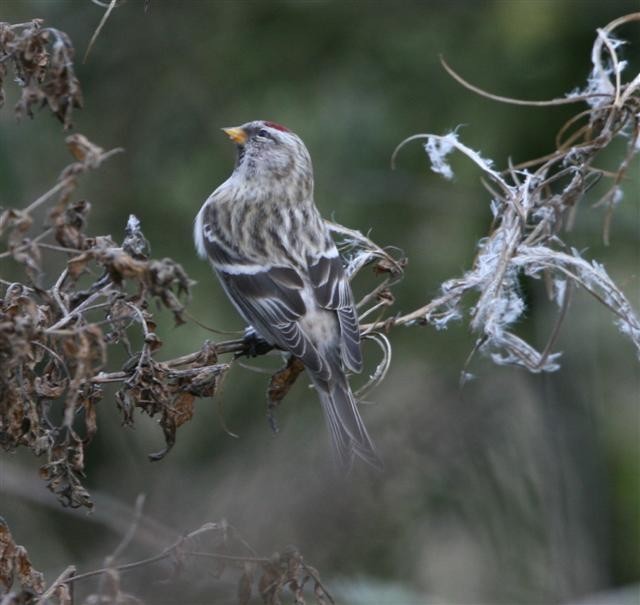
Arctic Redpoll, Marsh Lane NR (PERMIT ONLY), West Midlands (Photo:
Vince Garvey)
After all the debate surrounding the Oxfordshire gull, those looking to express an opinion eventually began to hone their thoughts on the Redpoll sp. present at Marsh Lane NR (West Midlands) from 3rd-9th (having been present well before the turn of the year and already being the subject of Internet debate). A strikingly pale bird, it seemed to show several features that could fall into the exilipes Arctic Redpoll box. Likewise, the bird also seemed to show some rather anomalous features for that species, and some observers felt that it may be just an exceptionally pale Mealy (Common) Redpoll. Other theories suggested Icelandic origin (where birds are notorious in their diverse appearance) and the dreaded hybrid word appeared too - and that is possibly the line worth investigating most. A fascinating bird and really obliging too.
Great Grey Shrikes saw a slight rise in numbers this week, with up to 18 birds recorded across the country. Two or three birds (at least) were noted around Hampshire, while two birds were in Devon on 9th. Two birds were present in Wales (in Glamorgan and Powys) while one was in Scotland, in Clyde.
Photo of the Week
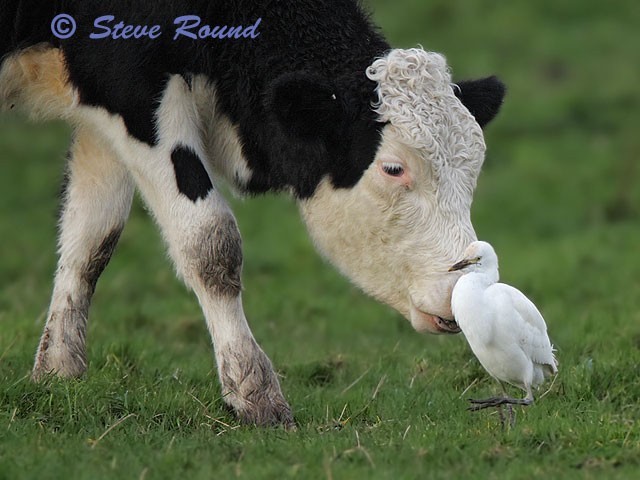
Cattle Egret, Neston, Cheshire (Photo:
Steve Round)
This week has seen large numbers of Cattle Egrets across the UK, enabling many bird photographers to add images of them to their collections. Over forty images have been uploaded to BirdGuides, with an impressively high standard being set. Taking bird photos that stand out from the crowd is increasingly difficult and often requires considerable creativity as well as technical excellence. With his image of an indignant egret being nudged by a cow, Steve has managed not only to achieve something distinctive, but also to incorporate something not often found in bird photos: humour!
Other notable photos

Barn Owl, Welney WWT, Norfolk (Photo:
David Whistlecraft)

Black-throated Diver, Burton Riggs NR, North Yorkshire (Photo:
Steve Race)
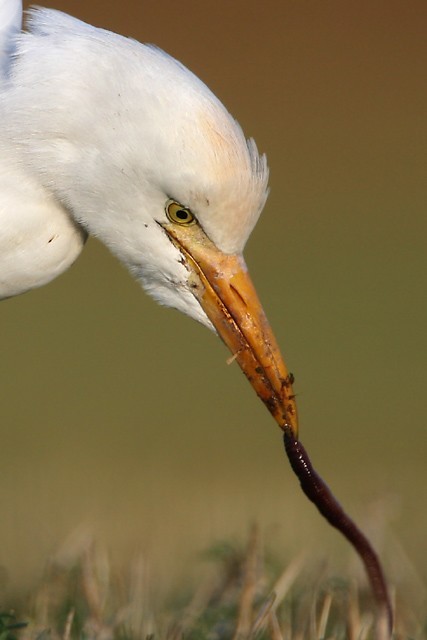
Cattle Egret, Cardoness, Dumfries & Galloway (Photo:
Fraser Simpson)

Snow Bunting, Salthouse, Norfolk (Photo:
Nick Clayton)

Purple Sandpiper, Aberystwyth, Ceredigion (Photo:
Mark Hancox)

Crested Tit, undisclosed site, Highland (Photo:
Marcus Conway)

Common Kestrel, Spain (Photo:
Steve Fletcher)

Mandarin Duck, Hereford, Herefordshire (Photo:
George Ewart)
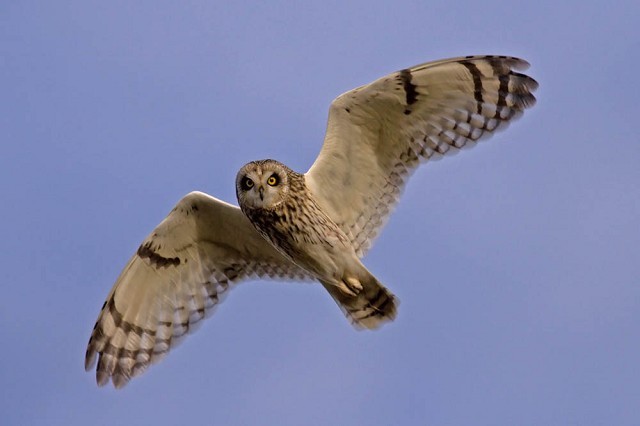
Short-eared Owl, Cow Down, Berkshire (Photo:
Stephen Burch)

European Stonechat, Cley Marshes NWT, Norfolk (Photo:
Nigel Pye)

Fieldfare, undisclosed site, Clwyd (Photo:
Richard Steel)

Siskin, Llandrindod Wells, Powys (Photo:
Kev Joynes)

